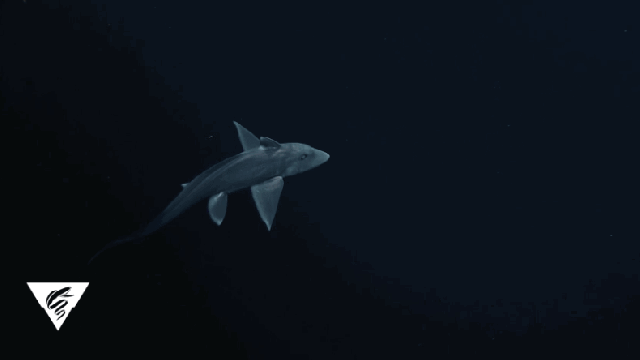Remotely operated vehicle surveys off the coast of California and Hawaii have produced several observations of a large deep sea ghost shark known as a “pointy-nosed blue chimaera.” The resulting video footage is the first ever recorded of this elusive species in its natural habitat.
Ghost sharks, or what marine biologists call chimaeras, are a family of unusual fishes whose bodies are stiffened not by bones, but by plates and bone-like bits of cartilage. The animals may be rare, but there are about 38 species of chimaeras around the world. Technically speaking, chimaeras are not sharks, having diverged from a common ancestor some 400 million years ago. These creatures, which are also related to rays, are veritable living fossils, confined to depths as low as 8,500 feet (2,600 meters).
Chimaeras have a haunting appearance to them, with seemingly dead eyes, bird-like fins, and skin that looks as though it’s armour plated. The males have a retractible penis on their heads, making them weirder still.
Back in 2009, researchers with the Monterey Bay Aquarium Research Institute (MBARI) captured unprecedented footage of a ghost shark in the Gulf of California, and it marked the first time a chimaera was captured on film. The researchers weren’t sure about the exact species, but the specimen did appear similar to two species of ghost sharks spotted elsewhere. The species was originally described from specimens found off New Caledonia in 2002, and is named in honour of artist Ray Troll who was fascinated by these fish.
Seven years after this footage was taken, marine biologist Lonny Lundsten and his colleagues say the fish in the video is likely a pointy-nosed blue chimaera (Hydrolagus trolli) — a fish previously identified only in the southwestern Pacific Ocean. Previous to this observation the fish was only seen near New Zealand and South Africa, marking the first time a chimaera has been spotted in the Northern Hemisphere.
Three different chimaera experts were recruited to help identify the fish. The researchers say it’s entirely possible that the specimen belongs to an entirely new species of ghost shark, but the only way to know will be to capture one and bring it up to the surface for analysis — not an easy task given its size, deep habitat, and the fact that these animals are endangered. For now, we’ll just have to admire this amazing video and hope for more in the future.
